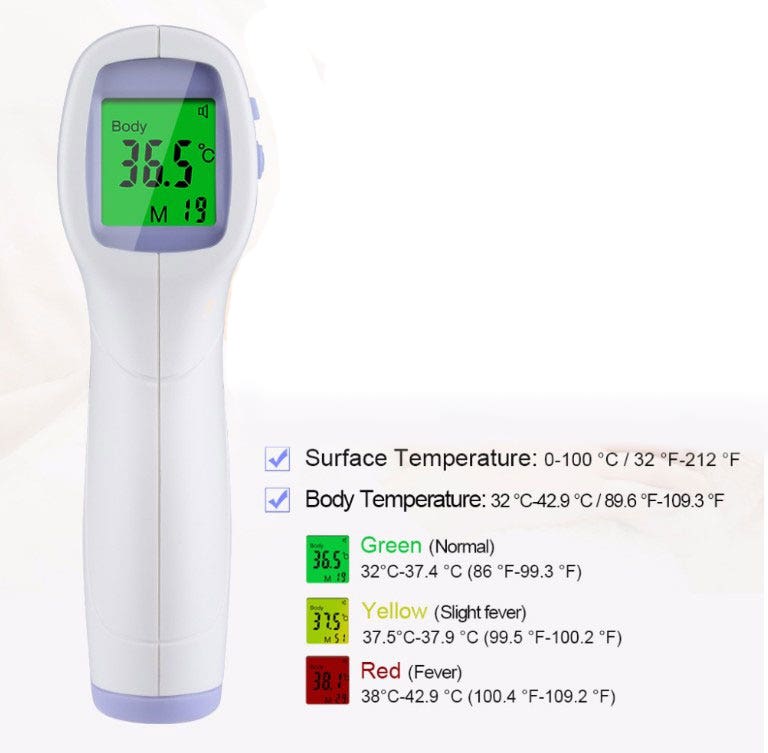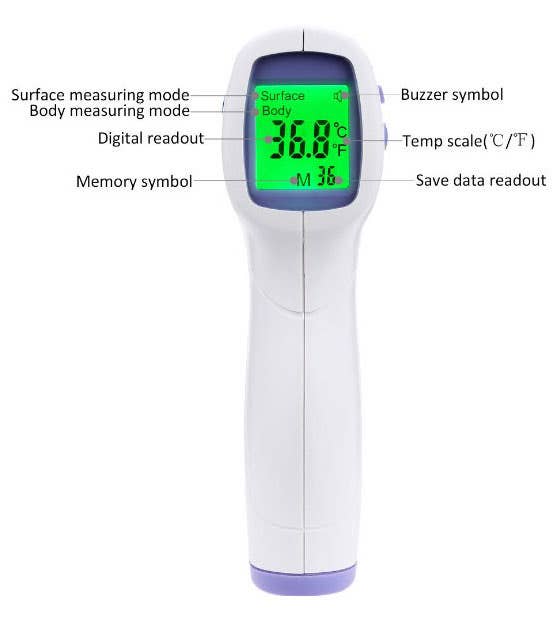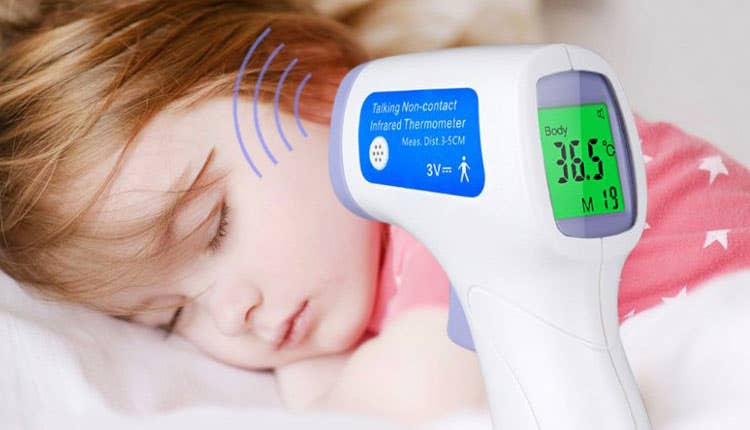With this ongoing COVID-19 coronavirus pandemic, the need for body thermometers for work, home, and on the go has never been greater. But not all thermometers are made equal so you need to know which ones are most effective for handling COVID-19 prevention and spread.
Although digital thermometers and forehead thermometer strips certainly have their place and are good tools to have, they are not quite as effective in handling this current pandemic as a non-contact thermometer. Using an infrared thermometer will allow you to be able to measure the temperatures of individuals while minimizing the risk to yourself by maintaining a safe distance apart from the potentially infected person.
But how exactly are these infrared thermometers able to do this? That is a question we explore in this detailed breakdown of your average infrared thermometer and how it works.
The Technology Behind a Non-Contact Thermometer
Within an infrared thermometer are several components that allow it to monitor the level of thermal radiation emitted by an object or individual. This setup essentially consists of a lens that is able to direct the infrared thermal radiation onto the detector. What this then does is convert the radiant power into an electric signal that can be read as temperature data.
Once the machine compensates for what it estimates the ambient temperature is, the mechanism is able to calculate the temperature of the object that it is pointed at. This is the basics of what is in an infrared thermometer and how it works to provide you with temperature readings without needing to ever touch the object.

How to Properly Use an Infrared Thermometer
Now that you have a better understanding of the process that is involved in an infrared thermometer, it is time to explain how to properly use this item. The first part of this involves better understanding when a non-contact thermometer is needed.
This will come in handy whenever there is an object that you are either unable or unwilling to touch. This could include measuring the temperature of objects like automotive parts, cooking oil, swimming pools, highly contagious individuals, and much more. If you ever find yourself in a situation like this, then it is highly recommended that you bring out your non-contact thermometer to help avoid having to risk harm or waste a significant amount of time trying to measure the temperature of the object using a different type of thermometer.
The first thing that you are going to do when trying out an infrared thermometer for the first time is playing around with the switch that controls the device’s measurement unit. Every one of these thermometers will be able to measure temperatures in both Celsius and Fahrenheit. Therefore, you need to make sure that the thermometer is set to the right measurement unit and that you also know how to switch it to the other unit in case it is ever needed for one reason or another.
Some of these infrared thermometers will also come with the ability to switch between measuring a body or surface object. Depending on what you are planning on measuring, you will also need to know how to switch between these two settings.
After you have mastered this part of the thermometer’s operation, you should make sure that it is ready to be used by either pressing the power button or gently squeezing the trigger just enough to wake it up but not enough to set it off. Then, aim the laser or end of the thermometer at whatever object you want to measure and make sure that you get as close as you comfortably can to the item.
Once you are pointed at the right target, you can hold the trigger down for approximately one to three seconds until the gun beeps or vibrates to indicate that its measurement is complete. This will bring the temperature up on the digital display and will provide you with a fairly accurate reading.

In fact, modern infrared thermometers can usually achieve an accuracy of about ±1.5 percent. But in order to achieve this level of accuracy or improve it even further, you need to know how to calibrate these infrared thermometers.
How to Easily Calibrate a Non-Contact Thermometer
When you are measuring the temperature of a person or an inanimate object, you want the resulting temperature to be incredibly accurate. Therefore, you need to know how to properly calibrate your thermometer so that it gives you as accurate a reading as possible.
This can be achieved in a few different ways. However, the simplest way to help calibrate a non-contact thermometer is to create an ice bath for the thermometer to measure. Luckily, this can be done by using a large glass rather than having to fill up an entire bathtub.
The first step in completing this calibration method is to grab a glass and completely fill it up with crushed ice. You will then need to add some cold water into the glass until the water level is about half an inch from the top of the glass. Stir the ice and water together and then allow the mixture to sit for a couple of minutes. After this is done, more water will need to be added until the glass is completely full.
At this point, you should make sure to set your infrared thermometer to an emissivity calibration of between 0.95 and 0.97. By doing so, it allows you to then point the lens of the thermometer directly above the surface of the water and press the trigger to get a reading of it. Once all of this has been completed, you should have a properly calibrated infrared thermometer that is able to deliver more reliable temperature readings.
Tips on How to Achieve Better Results While Using an Infrared Thermometer
Just because you have calibrated your non-contact thermometer, this does not necessarily mean that you are going to start getting the best results possible during every use. There is a wide variety of factors that could be affecting the quality of your temperature readings, which is why you need to take the time to read through these tips that are proven to help improve the results of an infrared thermometer.
The first thing that you need to do is figure out what distance-to-spot (D:S) ratio your infrared thermometer has. This ratio is what lets you know the size of the area that your thermometer is measuring when you are pointing it at an object or individual. Just like with a camera or a shotgun shell, the closer the object is to you, the more accurate the result is going to be. But as you get further away from the intended object, the area that you are affecting is growing exponentially.
 For example, if your particular thermometer has a D:S ratio of 10:1, it means that for every 10 inches you get away from your target, the area that the thermometer is targeting is going to have its diameter grow by one inch.
For example, if your particular thermometer has a D:S ratio of 10:1, it means that for every 10 inches you get away from your target, the area that the thermometer is targeting is going to have its diameter grow by one inch.
This is important to understand because it lets you know how far away you can get from a while still getting fairly accurate readings. If the thing you are trying to measure only has a diameter of a couple of inches, then this indicates that you can’t stand any further than 20 inches away from your target. If you go further back than this, then your infrared thermometer will begin to incorporate the temperatures of the area surrounding the intended object as well, which will significantly impact the reading that it gives you.
Another major tip that you will need to keep in mind is that trying to measure particularly shiny objects is going to pose a bit of a problem. This is because of its effect on the emissivity of the object. When something is rather dull, like wood, matte paint, plaster, rubber, or concrete, the material is going to have a high emissivity that will return normal temperature readings. However, any sort of shiny materials like polished metals or glossy paint is going to possess a much lower emissivity that will drastically impact the results from the thermometer.
So if you are going to try and measure the temperature of a shiny object, then you may want to think about putting some electrical tape or a layer of some flat paint on the object to help deliver more accurate results. Or you could instead look for an infrared thermometer that has an adjustable emissivity level that lets you compensate for shiny materials when needed.
With all of this information, you should now better understand an infrared thermometer and how it works. If you need infrared thermometers, we have them available within the iHealth section of iPromo.

